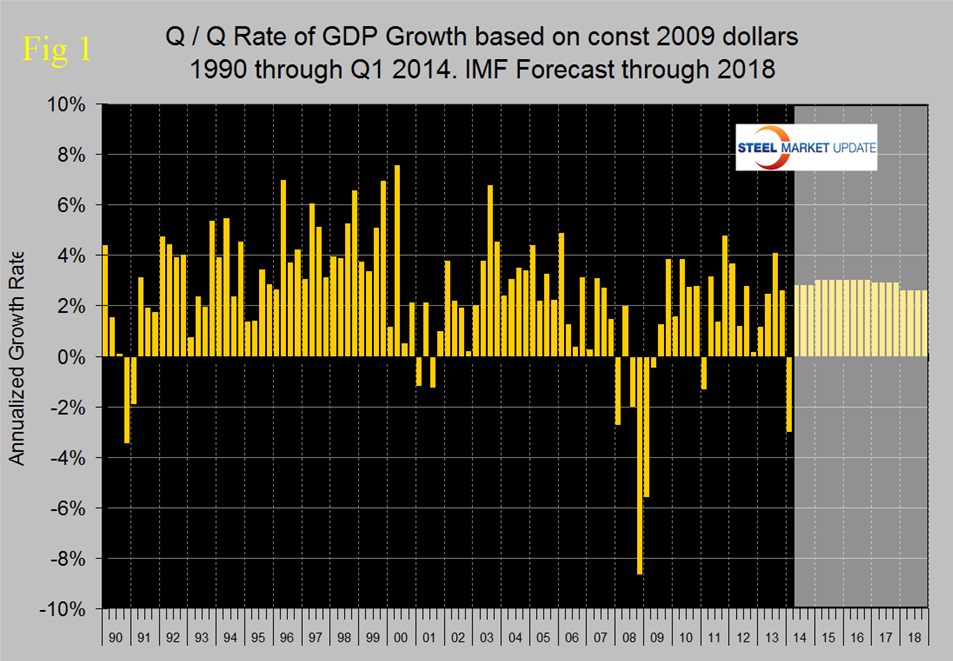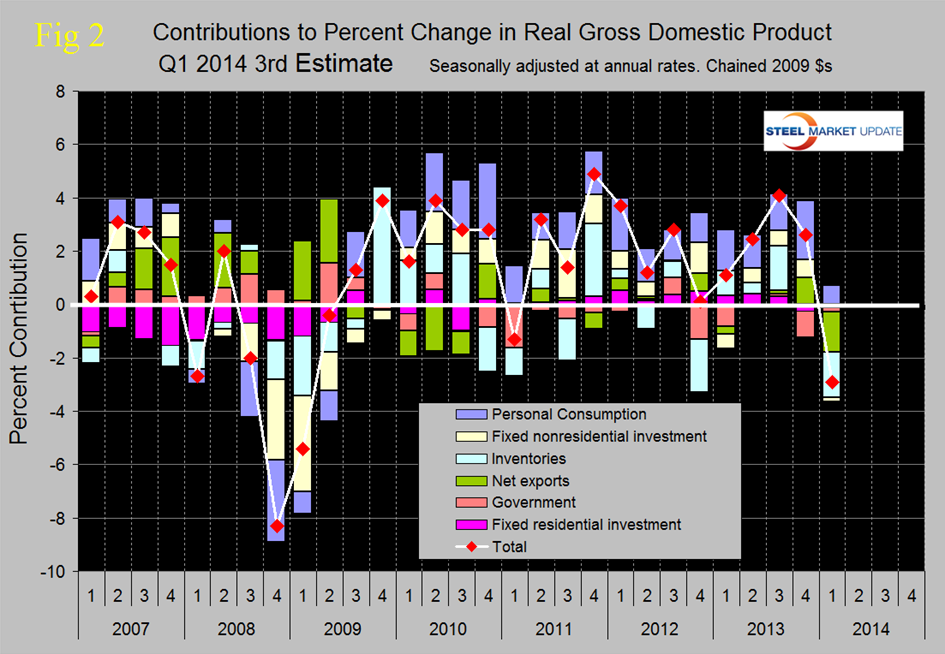Economy

First Quarter 2014 Third Estimate of United States GDP
Written by Peter Wright
June 30, 2014
The Bureau of Economic Analysis (BEA) estimate of US GDP growth was a shocker at negative 2.9 percent, this came after the first estimate which was positive 0.1 percent and the second estimate at negative 1.0 percent. This raises the question of whether early estimates are worth considering. The first estimate for the second quarter will be released at the end of July at which time further revisions will be reported back to 1999. At this time last year major historical revisions were reported and these were very significant. Changes in GDP are reported quarter on quarter. Year on year GDP grew at 1.55 percent.
Figure 1 shows quarterly results since 1990 and the latest IMF forecast through 2018. In its April review the IMF reduced its forecast for this year as a whole from 3.0 percent to 2.8 percent and for next year from 3.6 percent to 3.0 percent.
The third estimate for Q1 just released was almost a perfect storm for all major sub-components, this was not just a weather event. Figure 2 shows the change in major sub-components, everyone except fixed residential investment and government deteriorated, and both these had a negative, (though smaller) contribution.
The contribution of personal consumption fell from 2.22 percent to 0.71 percent. Fixed nonresidential investment fell from 0.68 percent to negative 0.14 percent. Inventories were a very major player in Q1 falling from negative .02 percent to negative 1.7 percent. In the long run the effect of inventories is a wash so this is merely moving numbers from one period to another. Net exports were also a huge factor in Q1 changing from a positive contribution of 0.99 percent in Q4 2013 to negative 1.53 percent in Q1. The change in net exports is believed to be due to a slowing in overseas markets particularly in the developing world. Government made a negative contribution of 0.14 percent in Q1 but this increased from negative 0.99 percent in Q4 2013. The contribution of fixed residential investment became less negative in Q1 at -0.13 percent improving from – 0.26 percent in Q4 2013. US GDP was poised to break through the $16 trillion level in Q1 but instead fell back to $15.824 trillion.
The Armada Executive Intelligence Brief made the following comment before the third estimate of Q1 was released: The fed has observed that the major decline in the national GDP came despite the fact that many of the domestic indicators were basically positive – jobs on the increase, recovery from the winter doldrums, improved capacity utilization and increased capital investment. The part that went wrong was that exports fell like a stone (almost a 10 percent decline). This was purely the result of poor economic performance in Europe and Asia. The point is that the US has no choice but to react to the rest of the world and if there is no recovery in global economics there will be little recovery in the US. Interest rates could well stay low for longer than anticipated if the Fed worries more about global growth and less about domestic inflation.
The official news release from the BEA read as follows:
Gross Domestic Product: First Quarter 2014 (Third Estimate)
Real gross domestic product — the output of goods and services produced by labor and property located in the United States — decreased at an annual rate of 2.9 percent in the first quarter of 2014 according to the “third” estimate released by the Bureau of Economic Analysis. In the fourth quarter of 2013, real GDP increased 2.6 percent. The GDP estimate released today is based on more complete source data than were available for the “second” estimate issued last month. In the second estimate, real GDP was estimated to have decreased 1.0 percent.
This downturn in the percent change in real GDP primarily reflected a downturn in exports, a larger decrease in private inventory investment, a deceleration in PCE, and downturns in nonresidential fixed investment and in state and local government spending that were partly offset by an upturn in federal government spending.
Real personal consumption expenditures increased 1.0 percent in the first quarter, compared with an increase of 3.3 percent in the fourth. Durable goods increased 1.2 percent, compared with an increase of 2.8 percent. Non-durable goods decreased 0.3 percent, in contrast to an increase of 2.9 percent. Services increased 1.5 percent, compared with an increase of 3.5 percent.
Real nonresidential fixed investment decreased 1.2 percent in the first quarter, in contrast to an increase of 5.7 percent in the fourth. Nonresidential structures decreased 7.7 percent, compared with a decrease of 1.8 percent. Equipment decreased 2.8 percent, in contrast to an increase of 10.9 percent. Intellectual property products increased 6.3 percent, compared with an increase of 4.0 percent.
Real residential fixed investment decreased 4.2 percent, compared with a decrease of 7.9 percent.
Real exports of goods and services decreased 8.9 percent in the first quarter, in contrast to an increase of 9.5 percent in the fourth. Real imports of goods and services increased 1.8 percent, compared with an increase of 1.5 percent.
Real federal government consumption expenditures and gross investment increased 0.6 percent in the first quarter, in contrast to a decrease of 12.8 percent in the fourth. National defense decreased 2.5 percent, compared with a decrease of 14.4 percent. Non-defense increased 5.9 percent, in contrast to a decrease of 10.0 percent. Real state and local government consumption expenditures and gross investment decreased 1.7 percent; it was unchanged in the fourth quarter.
The change in real private inventories subtracted 1.70 percentage points from the first-quarter change in real GDP, after subtracting 0.02 percentage point from the fourth-quarter change. Private businesses increased inventories $45.9 billion in the first quarter, following increases of $111.7 billion in the fourth quarter and $115.7 billion in the third.
Real final sales of domestic product — GDP less change in private inventories — decreased 1.3 percent in the first quarter, in contrast to an increase of 2.7 percent in the fourth.

Peter Wright
Read more from Peter WrightLatest in Economy

Architecture billings continue to slide in March
Architecture firms said billings continued to decline in March, according to the latest Architecture Billings Index (ABI) released by the American Institute of Architects (AIA) and Deltek.

Beige Book shows concerns about trade policy
Manufacturing was mixed, but two-thirds of districts said activity was little changed or had declined.

New York state manufacturing index drops again in April
Firms were pessimistic, with the future general business conditions index falling to its second lowest reading in the more than 20-year history of the survey

Construction adds 13,000 jobs in March
The construction sector added 13,000 jobs, seasonally adjusted, in March, but tariffs could undermine the industry.

Supply chains, end-users brace for impact from tariffs
Supply chains are working through what the tariffs mean for them


